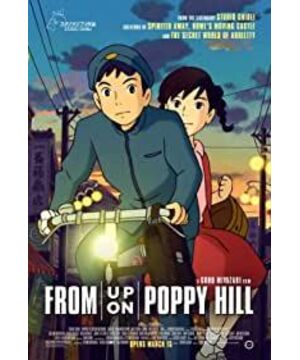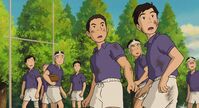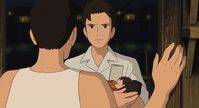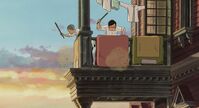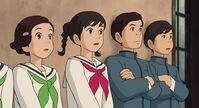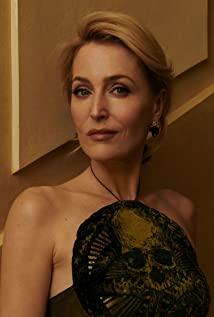Originally published in Issue 71 of "24 Grid"
Before walking into the cinema in Ikebukuro, someone gave me a different message again. It is said that even people who haven't watched the animation can see through this movie that "the animation seems to be drawn in layers"; but some people told me that she "would cry when she saw it". And my most direct feeling when buying tickets is "tickets seem to be easy to buy". A medium-sized screening hall is full of 6 shows a day, but the attendance rate is basically less than 50%, let alone people queuing up to buy tickets. I still remember how I felt when I came out of the theater of "Legend of Earthsea" and watched the people queuing up for tickets under the scorching sun. It seems that everyone is very cautious about Wulang this time.
And when I came out of the movie theater this time, I sent a text message to my colleague - "The movie "Puppet" is so good!" To be honest, it's been a long time since I had the experience of watching a movie in a movie theater. . The people in the picture laugh and I laugh, the people in the picture cry and I cry, and when the people in the picture are happy or sad, I can't close my mouth or frown with worry...so much so that I start to ignore the obvious clips Unsmooth, detached action from characters and backgrounds, and drawing mistakes that laymen would find strange. My personal favorite Ghibli movie, aside from the two monsters "Spirited Away" and "Princess Mononoke", is actually the realistic but not hard-working "Heard the Waves" and "Listen". And there are some parts of "Listening to the Side" that I really don't like, and I didn't realize until many years later that those parts were influenced by Hayao Miyazaki. To put it bluntly, I'm not someone who doesn't like to see Fantasy in cartoons - this seems to be the opposite of the vast majority of audiences... In my opinion, if "Listening" hadn't been so much fantasy elements by Hayao Miyazaki Going in, it really has something to do with "Hearing the Sound of the Waves". But Hayao Miyazaki is best at this stereotyped animated film commercial model, which determines that he cannot and will not learn to abandon the magical style and make a human relationship drama that is "no problem with live action". This aspect can be said to be the strengths of Takada Isao and Oshii Mamoru. Maybe it is time to add a Miyazaki Goro? The film feels like a happy Takada Isao (human drama), plus a popular Oshii Mamoru (resistance drama), and then a Miyazaki (comedy) who is not obsessed with fantasy. So you think the funny parts in this film are like "Heisei Beaver Fight", the emotional parts are like "Lucky Star Boy's Dream Come True", and the plot opening and closing are like "Spirited Away", which really creates a confrontation Mamoru Oshii appeared again... In addition, since Katsu Kondo, who also served as the character in "I Heard the Waves", also served as the character of the film, the authenticity of the film was greatly improved, and the background was restored as much as possible The appearance of Yokohama and Tokyo in 1963 is full of complexity, and there is no longer the thin effect of the stage play in "Earth Sea". In addition, a large number of 60s-style songs are inserted in the film, which really makes people who like old films feel "nostalgic". When I told a friend that I liked "Yu Meiren", she even directly commented, "That's because you like the era in 1963, right?" It can be seen that everyone agrees with the restoration of the scene atmosphere in this film.
The original work of this film is a manga of the same name by Chizuru Takahashi in 1980. In the mid-1980s, Hayao Miyazaki came across this manga by his niece, and was attracted by the story and drama, and even pulled Oshii to discuss how to adapt it into an animated film. The original work described the funny and hard-fought story of middle school students in the 1970s, just like a Qiong Yao drama, but Hayao Miyazaki made drastic changes when turning it into a movie this time. First of all, in addition to the feelings of the hero and heroine, a core conflict has been added-the survival and abandonment of the Latin House. "Latin House", derived from the "Latin Quarter", is a teaching area in Paris, France. It rose to fame in the student movement in the 1960s and is a symbol of the French street fortress struggle. In 1963, the middle school student union named its club building like this, which is a typical thinking of the times. The student protests about the abandonment of the Latin Building were also in line with the social trend of that era. Thankfully, this time Miyazaki didn't shove that part into something as inexplicable as the war in Howl's Moving City. The design of the Latin House, the community members who live in the Latin House, and the story itself surrounding the Latin House are very pleasing. So many criticisms of the film came from "Why not take Latin House as the core?" Secondly, the part of the original work that would destroy the main line of love between the hero and heroine was greatly trimmed. Originally, the hero was playing mahjong and gambling money. Therefore, to embezzle the funds of the social organization, this kind of content is meaningless in the film, so it must be gone. In addition, there is a male tenant named Beidou in Yumeirenzhuang, who is very attractive to the sea, which will distract the core attention of the film, so Beidou in the film is simply a bold and capable big sister. The various adaptations are aimed at highlighting two cores—the love between the hero and heroine, and the struggles of the young students. These two themes can actually be combined into one word, which is "youth". This work is actually a movie that celebrates youth, and Japanese movies haven't filmed this kind of positive (rather than comedy or violent drama) work that celebrates youth for a long time. So for people like me who like "old taste" and their noses get sour when they see the word "youth", this is really a big dish that has been waiting for a long time! Although it is true that the master in charge is not very proficient in the craftsmanship...
When joking, we also guess that the reason why this film is good is because Miyazaki Goro didn't actually do too many important things? Anyway, from the point of view of the storyboard, Wulang's storyboard still has no sense of coherence, that is, the pictures that are separated from each other are placed together in sequence. The coherence and movement are estimated to have to be guessed and checked by the animators and original artists themselves, right? Maybe Wulang is even playing a negative role that needs to be subtracted?
Speaking of the negative effects of Goro Miyazaki, just like what Lao Gong said at the premiere, this is a mistake only a layman would make. Ghibli was never the most technically Japanese company, they just had the most demanding directors in Japan ever. So when the director leads the team as a pure layman, it's hard to really get in on the technical mastery. For example, the "knee door" issue that has made a lot of noise. That is a picture of the heroine Hai walking out of the Latin Building, an action of her walking down the steps outside the Latin Building. When we humans go up the stairs, our knees will be raised forward and high; but when we go down the stairs, we will not. It won't lift up high. And the painting is just reversed here, making Matsuzaki Kai keep raising his knees forward and high as he descends the stairs, so high that his skirt is raised to a protrusion. In this way, the error in the picture becomes very obvious. As the heroine goes down the stairs, there is something bulging in the front direction of the bottom of the skirt... Lao Gong saw this picture at the time and felt disgusting in his heart. I can understand it, but I'm sure it's going to freak out on the spot.
Although many problems have been said, but overall, I still agree with this retro-style youth film. Maybe many viewers will think that such a work can be made into a live-action drama, so what kind of animation is it? But I just want to see Ghibli make an animation like this! This is what I expected from Ghibli - time to say goodbye to Hayao Miyazaki? Get out of your own way in the future! Goro, Kondo, and the young people of Ghibli, learn to ignore the teasing of the seniors and make movies in your own way! However, if Wu Lang wants to really enter the industry, it is estimated that he will have to draw for another ten or twenty years... During this period, I may be able to see the changes and growth of Ghibli!
The first version of Jun Kazama designed by PS Miyazaki Goro looks exactly like Yujiro Ishihara, the idol of Nikkatsu youth film in the 1960s and 1970s. If you can't understand this, you can't understand the feelings of Japanese people watching this movie.
View more about From Up on Poppy Hill reviews


